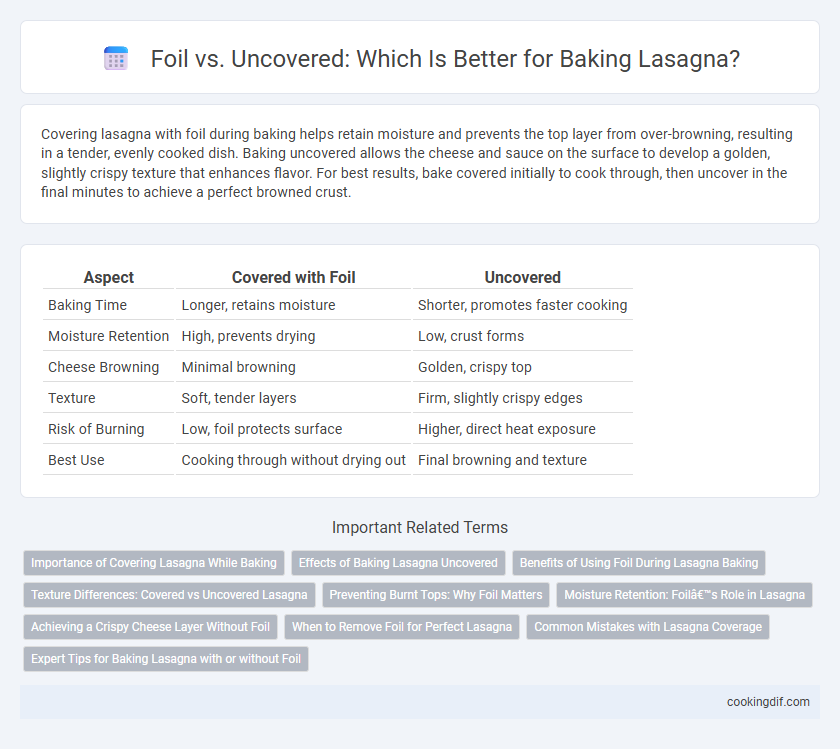Covering lasagna with foil during baking helps retain moisture and prevents the top layer from over-browning, resulting in a tender, evenly cooked dish. Baking uncovered allows the cheese and sauce on the surface to develop a golden, slightly crispy texture that enhances flavor. For best results, bake covered initially to cook through, then uncover in the final minutes to achieve a perfect browned crust.
Table of Comparison
| Aspect | Covered with Foil | Uncovered |
|---|---|---|
| Baking Time | Longer, retains moisture | Shorter, promotes faster cooking |
| Moisture Retention | High, prevents drying | Low, crust forms |
| Cheese Browning | Minimal browning | Golden, crispy top |
| Texture | Soft, tender layers | Firm, slightly crispy edges |
| Risk of Burning | Low, foil protects surface | Higher, direct heat exposure |
| Best Use | Cooking through without drying out | Final browning and texture |
Importance of Covering Lasagna While Baking
Covering lasagna with foil during baking helps retain moisture and ensures even cooking by preventing the top layer from drying out or burning. Uncovered lasagna often develops a crispier, browned cheese crust but risks uneven cooking and dried-out edges. Using foil for most of the baking time, then uncovering it toward the end, achieves a balanced texture with a moist interior and appealingly golden top.
Effects of Baking Lasagna Uncovered
Baking lasagna uncovered allows the top layer of cheese to brown and develop a crispy, golden crust due to direct heat exposure, enhancing flavor and texture. However, this method can cause the pasta to dry out and the sauce to reduce excessively, leading to a less moist lasagna. To maintain balance, uncovered baking is recommended only during the last 10-15 minutes to achieve a desirable crust without compromising moisture.
Benefits of Using Foil During Lasagna Baking
Covering lasagna with foil during baking helps retain moisture, preventing the pasta and layers from drying out while ensuring even heat distribution. The foil also protects the cheese topping from over-browning, allowing it to melt thoroughly without burning, resulting in a creamy texture. This method promotes consistent cooking throughout the dish, enhancing the overall flavor and tenderness.
Texture Differences: Covered vs Uncovered Lasagna
Covering lasagna with foil during baking traps steam, resulting in a moister, softer texture with tender pasta layers and well-melted cheese. Baking uncovered allows the top layer to brown and crisp, creating a golden, slightly crunchy crust that contrasts with the creamy interior. The choice between covered and uncovered baking directly influences whether the lasagna ends up with a smooth, velvety texture or a textured, caramelized finish.
Preventing Burnt Tops: Why Foil Matters
Covering lasagna with foil during baking effectively prevents the top layer from burning by reflecting heat and retaining moisture, resulting in a tender, evenly cooked surface. Leaving lasagna uncovered exposes the cheese and sauce to direct oven heat, increasing the risk of a scorched, dry crust. Using foil ensures the delicate balance between a perfectly melted topping and a beautifully cooked interior without sacrificing texture or flavor.
Moisture Retention: Foil’s Role in Lasagna
Covering lasagna with foil during baking significantly enhances moisture retention, preventing the sauce and cheese from drying out and ensuring a tender, flavorful dish. The foil traps steam, creating a humid environment that maintains the lasagna's succulence and texture. Baking uncovered promotes a crispier top layer but risks drying the interior, making foil an essential tool for balanced moisture in baked lasagna.
Achieving a Crispy Cheese Layer Without Foil
Baking lasagna uncovered allows heat to directly brown and crisp the top cheese layer, creating a desirable golden crust that foil prevents by trapping moisture. Without foil, the cheese undergoes the Maillard reaction more effectively, enhancing flavor and texture. For a perfectly crispy cheese topping, omit foil during the final 15-20 minutes of baking to ensure a crunchy, savory finish.
When to Remove Foil for Perfect Lasagna
Removing foil during lasagna baking is crucial to achieve a perfectly browned and bubbly top while preventing excessive moisture buildup. Start by covering the lasagna with foil to retain heat and moisture for about two-thirds of the baking time, then remove the foil in the last 15-20 minutes to allow the cheese to melt and develop a golden crust. This method balances tenderness and crispness, ensuring the lasagna is cooked evenly without drying out.
Common Mistakes with Lasagna Coverage
Covering lasagna with foil during baking helps retain moisture and prevents the top layer from burning, but leaving it covered for the entire baking time often results in a soggy texture. A common mistake is failing to remove the foil in the last 10-15 minutes, which allows the cheese to brown and develop a desirable crispy crust. Baking uncovered from the start exposes the dish to direct heat, leading to over-dried edges and uneven cooking, so timing the foil removal is crucial for optimal lasagna texture.
Expert Tips for Baking Lasagna with or without Foil
Covering lasagna with foil during baking helps retain moisture, preventing the top layer from drying out while allowing even heat distribution for thoroughly cooked layers. Baking uncovered in the final 10-15 minutes promotes a golden, crispy cheese topping that adds texture and flavor. Experts recommend starting covered to ensure tender pasta and bubbling sauces, then removing the foil for browning to achieve the perfect balance between moistness and a crisp, appetizing crust.
Covering with Foil vs Uncovered for baking Infographic

 cookingdif.com
cookingdif.com